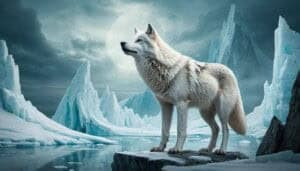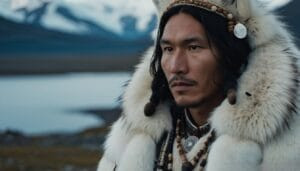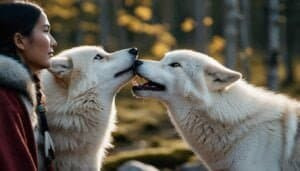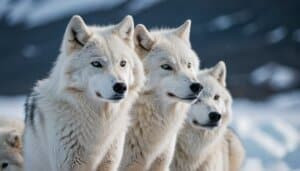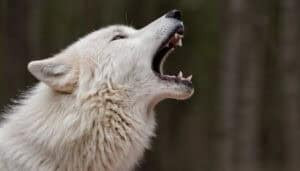Introduction
Arctic wolves hold a significant place in the spiritual and cultural practices of Arctic shamans. These majestic creatures are often featured prominently in dreams and visions, serving as powerful symbols and guides
This article explores the various aspects of Arctic wolves in shamanic traditions, including their symbolic meanings, roles in rituals, and influence on healing practices. We will also delve into the cultural and historical context of these animals in shamanism and examine modern perspectives on their significance
Symbolism and Communication in Shamanic Dreams
Arctic wolves are central figures in the spiritual practices of Arctic shamans, often appearing in dreams and visions as symbols of guidance, strength, and transformation
These mystical encounters are not merely figments of the subconscious but are believed to be profound spiritual experiences that connect shamans with the wisdom of the natural world
Symbolic Meanings of Wolves
In shamanic traditions, Arctic wolves symbolize various qualities and concepts
They are often seen as:
Guides and Protectors: Wolves in shamanic dreams frequently serve as spirit guides, leading shamans through spiritual journeys and protecting them from negative energies or harmful spirits
The wolf’s keen instincts and prowess in navigating the harsh Arctic environment are mirrored in its role as a guide in the spiritual realm
Strength and Endurance: The resilience and adaptability of Arctic wolves in the face of extreme conditions are admired and emulated by shamans
Dreams featuring wolves can symbolize the dreamer’s own inner strength and capacity for endurance in challenging situations
Transformation and Change: Wolves are also associated with transformation
Their presence in dreams can indicate significant personal or spiritual change. Shamans interpret these dreams as messages to embrace change and trust in the natural cycles of life
The symbolic meanings of Arctic wolves are deeply rooted in the natural characteristics of the animal. Their behaviors and traits in the wild are seen as reflections of spiritual truths, making them powerful symbols in shamanic practices
Communication with Wolf Spirits
Arctic shamans believe that dreams and visions involving wolves are not merely symbolic but also involve direct communication with wolf spirits
This communication can take various forms:
Telepathic Messages: Shamans may receive telepathic messages from wolf spirits, imparting wisdom or guidance on specific issues. These messages are often clear and direct, providing insights that the shaman can use in their healing practices or personal life
Spiritual Journeys: Wolves often appear as companions or guides during shamanic journeys, which are deep meditative states where shamans travel to the spirit world. In these journeys, wolves can lead shamans to important spiritual discoveries or healing powers
Visions and Omens: Sometimes, the appearance of wolves in dreams or visions is seen as an omen, predicting future events or highlighting areas of concern. Shamans interpret these signs through rituals and meditative practices, seeking to understand the messages conveyed by the wolf spirits
The communication between shamans and wolf spirits is a cornerstone of Arctic shamanic practices, reflecting a profound connection with the natural world and its spiritual dimensions
Common Themes in Wolf Dreams
Dreams involving Arctic wolves often share common themes and motifs, which shamans interpret to glean deeper meanings
Some prevalent themes include:
Hunting and Survival: Dreams where wolves are hunting can symbolize the shaman’s own struggles or challenges in life. These dreams may suggest the need for strategic thinking and perseverance
Pack Dynamics: Seeing wolves in packs can represent community and social relationships. These dreams might emphasize the importance of working together and supporting one another within the shaman’s community
Loneliness and Isolation: A lone wolf appearing in dreams can indicate feelings of isolation or a need for self-reliance. Shamans may interpret such dreams as a call to embrace solitude and inner strength
Natural Elements: Wolves interacting with elements like snow, ice, or the Northern Lights in dreams can highlight the interconnectedness of nature and the spiritual world. These elements often enhance the symbolic messages conveyed by the wolf
By analyzing these themes, Arctic shamans can better understand the spiritual messages and guidance offered through their dreams, allowing them to apply this wisdom to their lives and the lives of those they serve
Rituals and Healing Practices
Arctic wolves play a crucial role in the rituals and healing practices of Arctic shamans
These rituals, deeply embedded in the cultural traditions of Arctic communities, harness the symbolic power and spiritual presence of wolves to promote healing, spiritual growth, and community well-being
Rituals Involving Arctic Wolves
Arctic shamans incorporate wolves into various rituals, drawing on their spiritual significance and connection to the natural world
Some key rituals include:
Spirit Summoning Ceremonies: Shamans conduct ceremonies to summon the spirit of the Arctic wolf, seeking guidance, protection, or wisdom
These ceremonies often involve chanting, drumming, and the use of wolf-related artifacts such as bones, fur, or carved figurines. The summoned wolf spirit is believed to assist in navigating complex spiritual matters or providing strength during difficult times
Transformation Rituals: In rituals aimed at personal transformation or growth, shamans invoke the wolf as a symbol of change and adaptability
Participants may undergo symbolic journeys guided by the wolf spirit, helping them to embrace new phases of life and release old patterns. These rituals often take place during significant life events, such as coming-of-age ceremonies or before major life changes
Protection Rites: To safeguard individuals or communities from negative energies or malevolent spirits, shamans perform protection rites involving the Arctic wolf
The wolf’s fierce and protective nature is harnessed to create a spiritual barrier, warding off harm and ensuring safety. These rites may include the use of wolf totems, protective charms, and the drawing of symbolic wolf tracks around the protected area
The rituals involving Arctic wolves are intricate and carefully designed to align with the natural characteristics and spiritual attributes of the wolves, ensuring that their power is effectively channeled for the intended purposes
Healing Practices and Wolf Dreams
Arctic shamans often use their dreams about wolves as a foundation for healing practices. These dreams provide insights and guidance that are integral to the shaman’s role as a healer
Key aspects of these healing practices include:
Diagnostic Dreams: Shamans interpret wolf dreams to diagnose illnesses or spiritual imbalances
The presence and behavior of wolves in these dreams can reveal the nature of the ailment and suggest appropriate healing methods. For example, a dream where a wolf is injured might indicate a physical ailment, while a dream of a wolf howling could point to emotional distress or spiritual disconnection
Healing Journeys: Guided by wolf spirits, shamans embark on spiritual journeys to seek healing for themselves or others
These journeys, often undertaken in a trance state, allow shamans to access spiritual realms and gather healing energy. The wolf serves as a guide and protector, ensuring that the shaman can navigate these realms safely and effectively
Restorative Rituals: Drawing on the strength and resilience of wolves, shamans perform restorative rituals to promote physical and emotional healing
These rituals may involve the use of wolf-themed songs, dances, and medicinal herbs associated with the wolf spirit. Participants are encouraged to connect with the energy of the wolf, drawing on its power to restore balance and well-being
Healing practices rooted in wolf dreams are a testament to the deep spiritual connection between Arctic shamans and the natural world. By interpreting these dreams and incorporating them into their healing work, shamans can provide effective and holistic care to their communitie
Cultural and Historical Context
Arctic wolves have long held a significant place in the cultural and historical context of Arctic shamanism
Their presence is deeply woven into the myths, legends, and historical practices of the Arctic peoples, highlighting the profound respect and reverence these communities have for wolves
Stories and Legends of Arctic Wolves
Arctic wolves feature prominently in the folklore and mythology of Arctic cultures. These stories and legends serve to convey important cultural values and spiritual lessons
Some notable examples include:
Creation Myths: In many Arctic creation myths, wolves are revered as creators or essential beings in the formation of the world
For instance, some Inuit legends describe a great wolf spirit that shaped the land and brought order to the chaos. This highlights the wolf’s role as a powerful and foundational force in the natural and spiritual worlds
Heroic Tales: Wolves are often depicted as companions or guides to heroes in Arctic legends
These stories emphasize the wolf’s qualities of loyalty, bravery, and wisdom. A common motif is the lone wolf guiding a lost hunter back to safety, symbolizing the importance of trust and cooperation between humans and wolves
Moral Lessons: Many legends involving Arctic wolves are used to teach moral lessons
For example, tales of wolves protecting their packs from threats can illustrate the values of community and mutual support. Conversely, stories of wolves facing hardships due to human actions can serve as cautionary tales about respecting nature and wildlife
These stories and legends reflect the deep cultural significance of Arctic wolves, illustrating their vital role in the spiritual and moral fabric of Arctic societies
Historical Evidence of Wolves in Shamanism
The historical role of Arctic wolves in shamanism is well-documented, with evidence spanning centuries of spiritual practice and cultural expression
Key aspects of this historical evidence include:
Archaeological Finds: Artifacts such as wolf carvings, amulets, and ceremonial items have been found in archaeological sites across the Arctic region
These items indicate the long-standing reverence for wolves and their integration into spiritual practices. For example, wolf bones found in shamanic burial sites suggest that wolves were seen as powerful spiritual allies in both life and death
Historical Records: Accounts from early explorers and missionaries in the Arctic often mention the importance of wolves in shamanic rituals and beliefs
These records provide valuable insights into the historical practices and cultural contexts of Arctic shamans. Descriptions of wolf dances, chants, and totemic symbols highlight the central role of wolves in shamanic traditions
Oral Traditions: The oral histories of Arctic communities are rich with references to wolves and their spiritual significance
These traditions, passed down through generations, preserve the knowledge and practices associated with wolf symbolism in shamanism. Elder shamans and community leaders continue to share stories and teachings about wolves, ensuring that their cultural and spiritual legacy endures
The historical evidence underscores the enduring presence of Arctic wolves in shamanic traditions, reflecting their integral role in the spiritual and cultural life of Arctic peoples
Modern Shamanic Views
In contemporary Arctic communities, the significance of Arctic wolves in shamanic practices has evolved, yet their importance remains steadfast
Modern shamans continue to revere wolves as powerful spiritual entities, adapting traditional beliefs to address contemporary challenges while maintaining the essence of their ancestral heritage
Contemporary Practices
Modern Arctic shamans incorporate wolves into their practices in ways that blend traditional wisdom with current spiritual needs
Some contemporary practices include:
Digital Shamanism: With the advent of technology, some shamans use digital platforms to conduct rituals and share teachings about Arctic wolves
Virtual ceremonies, online courses, and digital storytelling allow shamans to reach a broader audience and keep the traditions alive. This modern approach ensures that the spiritual significance of wolves is accessible to younger generations who may be more attuned to digital communication
Environmental Activism: Many contemporary shamans view the protection of Arctic wolves and their habitats as a sacred duty. They engage in environmental activism, advocating for conservation efforts to protect these animals and the delicate ecosystems they inhabit
By emphasizing the spiritual connection between humans and wolves, shamans can inspire their communities to take action against threats like climate change and industrial development
Healing and Therapy: Arctic wolves are integrated into modern therapeutic practices. Shamans may incorporate wolf symbolism into counseling sessions, using stories and imagery of wolves to help individuals navigate personal challenges
This therapeutic use of wolf symbolism can provide comfort and guidance, reinforcing the healing aspects of shamanic traditions
Contemporary shamanic practices demonstrate the adaptability of ancient beliefs, ensuring that the spiritual connection with Arctic wolves remains relevant and impactful in today’s world
Wolf Symbolism Today
In modern Arctic communities, the symbolism of wolves continues to resonate deeply, reflecting both traditional values and contemporary realities
Key aspects of wolf symbolism today include:
Cultural Identity: Wolves remain a powerful symbol of cultural identity for many Arctic peoples
They embody the resilience, strength, and adaptability required to thrive in the harsh Arctic environment. By maintaining a strong connection to wolf symbolism, Arctic communities can preserve their cultural heritage and foster a sense of pride and unity
Spiritual Guidance: Wolves continue to be seen as spiritual guides, offering wisdom and support through life’s challenges
Modern shamans emphasize the importance of listening to the lessons that wolf spirits impart, whether through dreams, visions, or meditative practices. This ongoing relationship with wolf spirits helps individuals stay connected to their spiritual roots and navigate the complexities of modern life
Resilience and Survival: The traits of resilience and survival that wolves represent are particularly relevant in contemporary times, as Arctic communities face numerous challenges such as climate change, economic pressures, and social change
The symbolism of the wolf as a survivor and protector provides a source of inspiration and strength, encouraging communities to adapt and persevere
By maintaining the symbolic significance of wolves, modern Arctic shamans ensure that these powerful spiritual entities continue to play a vital role in the cultural and spiritual life of their communities
Conclusion
Arctic wolves hold a profound and enduring significance in the dreams and visions of Arctic shamans, reflecting a deep spiritual connection that transcends generations
These majestic creatures symbolize guidance, strength, and transformation, appearing in shamanic dreams as powerful spiritual guides. Through rituals and healing practices, shamans harness the symbolic power of wolves to promote well-being and spiritual growth
The rich cultural and historical context of Arctic wolves in shamanism underscores their integral role in the spiritual and cultural fabric of Arctic communities. Even in modern times, the reverence for Arctic wolves persists, adapting to contemporary challenges while preserving the essence of ancient traditions
This enduring connection ensures that Arctic wolves remain a vital symbol of resilience, wisdom, and spiritual guidance in the ever-evolving practice of Arctic shamanism




